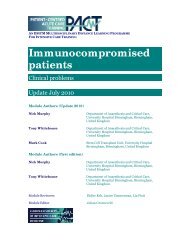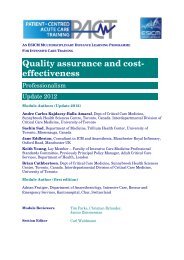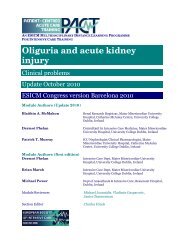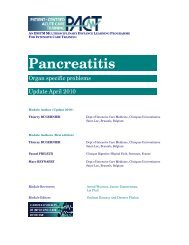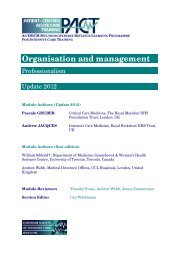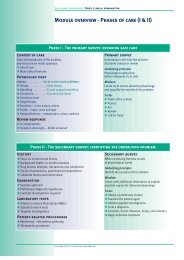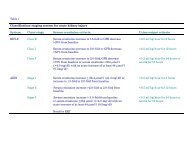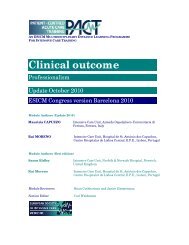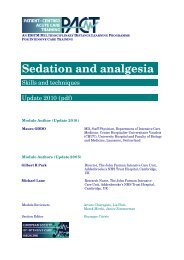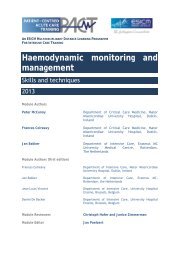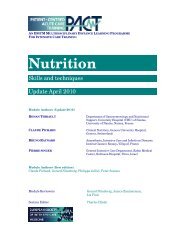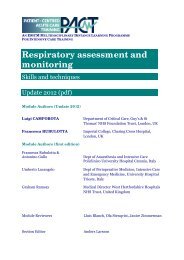Burns injury - PACT - ESICM
Burns injury - PACT - ESICM
Burns injury - PACT - ESICM
Create successful ePaper yourself
Turn your PDF publications into a flip-book with our unique Google optimized e-Paper software.
Another important complication during burn surgery is the septic effects on the<br />
circulation and haemostasis. Such effects may be significant but are most common in<br />
large burns and later during the course of treatment. In such cases infection<br />
surveillance and diagnosis and the choice of appropriate antibiotics are essential.<br />
Active temperature control during surgery<br />
One very important topic in burn surgery is temperature control. The patient is losing<br />
heat for several reasons: evaporative losses as dressings are removed; a<br />
nonfunctional skin barrier for temperature control; and cooling as surgical washing of<br />
the skin is made. These reasons make it mandatory to have a close temperature<br />
surveillance (e.g. via bladder catheter) and using active heating devices, the most<br />
successful being convective heat devices. Other means are keeping the operating<br />
room warm, warming the ventilator breathing system (circuit), warming all fluids<br />
given to the patient and limiting the amount of time in the operating room.<br />
Hypothermia prevention: give this high priority!<br />
Hypothermia favours coagulation disorders with bleeding and worsens outcome!<br />
Increased mortality has been shown in patients with delayed recovery of<br />
normothermia after surgery!<br />
See <strong>PACT</strong> module on Bleeding and thrombosis.<br />
Yowler CJ. Recent advances in burn care. Curr Opin Anaesthesiol 2001; 14(2):<br />
251–255. PMID 17016410<br />
Berger MM, Bernath MA, Chioléro RL. Resuscitation, anaesthesia and analgesia<br />
of the burned patient. Curr Opin Anaesthesiol 2001; 14(4): 431–435.<br />
PMID 17019126<br />
MacLennan N, Heimbach DM, Cullen BF. Anesthesia for major thermal <strong>injury</strong>.<br />
Anesthesiology 1998; 89(3): 749–770. PMID 9743414<br />
Janzekovic Z. A new concept in the early excision and immediate grafting of<br />
burns. J Trauma 1970; 10(12): 1103–1108. PMID 4921723<br />
Kjellman BM, Fredrikson M, Glad-Mattsson G, Sjöberg F, Huss FR. Comparing<br />
ambient, air-convection, and fluid-convection heating techniques in<br />
treating hypothermic burn patients, a clinical RCT. Ann Surg Innov Res<br />
2011; 5(1): 4. PMID 21736717<br />
40




